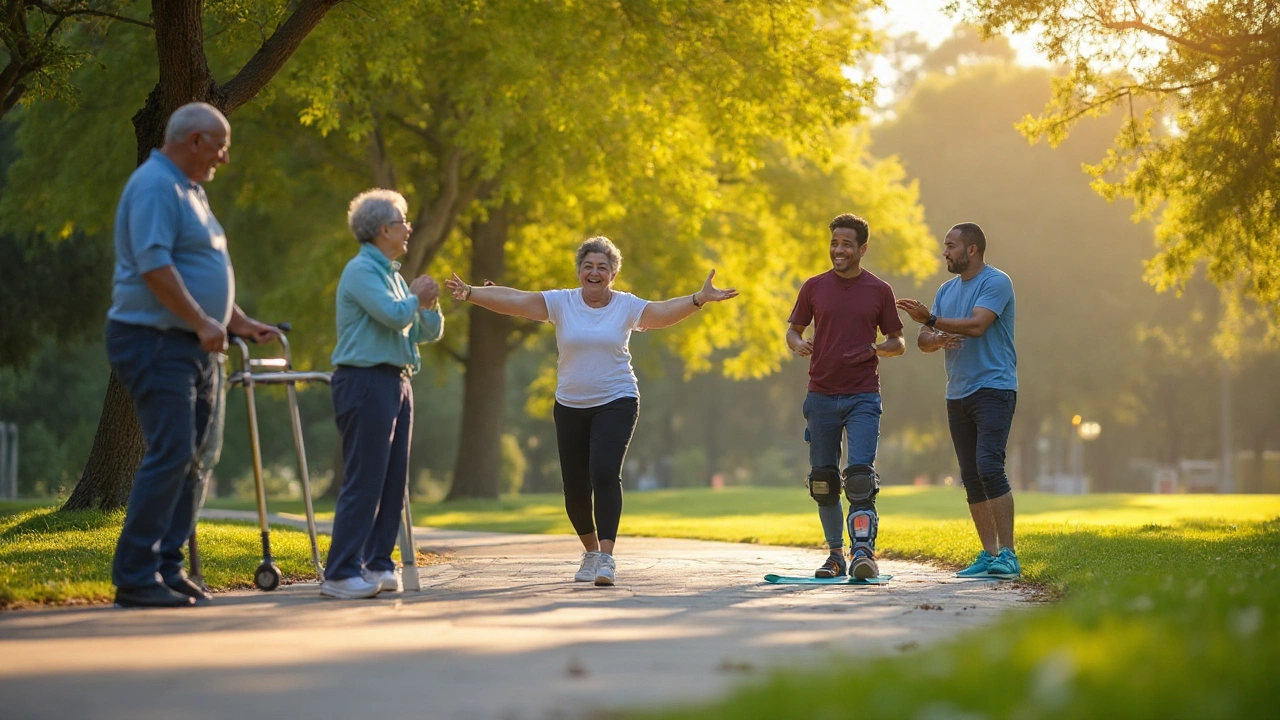Chronic Pain Associated with Joint Damage is a persistent ache or stiffness that stems from deterioration, injury, or disease affecting the joints. It shows up most often in people with Osteoarthritis, an age‑related wear‑and‑tear condition, or Rheumatoid Arthritis, an autoimmune inflammation that erodes joint surfaces.
Managing this kind of pain isn’t about a single magic pill; it’s a blend of assessments, daily habits, therapies, and-when needed-medical interventions. Below is a step‑by‑step guide that covers the whole spectrum, so you can craft a plan that fits your life.
1. Pinpoint the Source and Measure the Pain
Before you can treat anything, you need to know exactly what you’re dealing with. A simple pain assessment tool, such as the Visual Analog Scale (VAS) or the Numeric Rating Scale (NRS), lets you record intensity (0‑10) and track changes over weeks. Pair the score with a brief diary noting activities, weather, and medication timing. Patterns emerge quickly-maybe the pain spikes after a long walk or eases after a warm shower.
2. Tackle Inflammation Early
Inflammation fuels the hurt. Non‑steroidal anti‑inflammatory drugs (NSAIDs) like ibuprofen or naproxen block the enzymes that produce prostaglandins, cutting both swelling and pain. For people who can’t tolerate stomach irritation, acetaminophen offers a gentler analgesic profile, though it lacks strong anti‑inflammatory action.
3. Move Smart - Exercise and Physical Therapy
Physical therapy is a supervised program that blends stretching, strengthening, and low‑impact cardio to improve joint stability. A certified therapist will teach you a customized exercise program that targets the affected area while safeguarding against over‑use. Typical components include:
- Range‑of‑motion drills (e.g., heel slides for knees)
- Resistance band work to rebuild muscle around the joint
- Aquatic exercise, which reduces load by up to 90%
4. Temperature Therapy - Heat and Cold
Heat dilates blood vessels, easing muscle tension, while cold numbs nerves and curtails swelling. Use a warm pack for 15‑20 minutes before activity to loosen joints, then apply an ice pack for 10 minutes after exercise to keep inflammation in check. Alternate cycles work especially well for knee and shoulder pain.
5. Weight Management and Nutrition
Extra pounds mean extra pressure on weight‑bearing joints. Even a 5% weight loss can lower knee pain by up to 30%. Combine modest calorie reduction with a diet rich in omega‑3 fatty acids (found in salmon, flaxseed) and antioxidant‑dense foods (berries, leafy greens) to fight systemic inflammation.
6. Supplements That May Help
While no supplement replaces medical treatment, some people find relief with glucosamine and chondroitin, which support cartilage structure. Clinical trials show modest improvement in pain and function for up to 12 weeks, especially when combined with regular exercise.
7. Assistive Devices and Joint Protection
Simple tools like a cane, knee brace, or ergonomic kitchen gadgets can off‑load stressed joints. A well‑fitted assistive device reduces mechanical strain, allowing you to stay active without over‑taxing the joint. Choose devices based on the joint involved-ankle‑support shoes for foot pain, a lumbar roll for lower‑back stress, etc.

8. Mind‑Body Techniques - CBT and Relaxation
Cognitive Behavioral Therapy (CBT) teaches you to reframe pain‑related thoughts, use pacing strategies, and practice relaxation breathing. Studies from the Canadian Pain Society show CBT can lower reported pain intensity by 1‑2 points on the 0‑10 scale, even when the physical injury stays the same.
9. When Medication Needs a Boost
If over‑the‑counter options aren’t enough, a physician may prescribe gabapentin, a neuropathic pain agent that dampens nerve signals. It’s especially useful when joint damage triggers nerve irritation. Dosage starts low (300mg at night) and is titrated up to 900mg three times daily, monitoring for dizziness.
10. Surgical Options - When Conservative Care Fails
Joint replacement surgery (hip, knee, shoulder) is a last‑resort but can restore function dramatically. Current data from Ontario hospitals indicate a 90% satisfaction rate after hip arthroplasty, with pain scores dropping to 1 or lower within six months.
Putting It All Together - A Sample Weekly Plan
- Monday‑Friday: Morning gentle stretching (10min), followed by a 30‑minute low‑impact cardio (e.g., stationary bike). Post‑exercise: 15min heat pack.
- Tuesday & Thursday: Physical‑therapy session focused on resistance bands and balance drills.
- Saturday: Outdoor walk (choose flat terrain) + ice pack after returning.
- Sunday: Rest day with mindfulness meditation (10min) and a review of pain diary.
Adjust the plan based on your VAS score: if pain climbs above 6, add an extra NSAID dose (if safe) or increase ice duration.
Medication Comparison Table
| Medication | Primary Action | Typical Dose | Key Side Effects |
|---|---|---|---|
| NSAIDs (e.g., ibuprofen) | Anti‑inflammatory + analgesic | 200‑400mg every 4‑6h | Stomach irritation, kidney strain |
| Acetaminophen | Analgesic only | 500‑1000mg every 6h | Liver toxicity at >4g/day |
| Gabapentin | Neuropathic pain modulator | 300mg up to 900mg three times daily | Dizziness, fatigue |
Monitoring Progress and Knowing When to Adjust
Every two weeks, review your pain diary:
- Has the VAS score dropped at least 1 point?
- Are you able to complete daily tasks with less discomfort?
- Any new side effects from medication?
Key Takeaways
Managing chronic joint pain is a marathon, not a sprint. Combine accurate pain measurement, anti‑inflammatory meds, targeted exercise, temperature therapy, weight control, supplements, assistive devices, and mind‑body coping. Reserve surgery for cases where all else fails. Consistency and regular check‑ins are the secret sauce.

Frequently Asked Questions
Can I rely solely on supplements to ease joint pain?
Supplements like glucosamine and chondroitin can provide modest relief, but they work best when paired with exercise and weight management. They shouldn’t replace NSAIDs or physical therapy for moderate‑to‑severe pain.
Is heat therapy safe for inflamed joints?
Heat helps relax muscles and increase blood flow, but it can temporarily boost inflammation if used on an acutely swollen joint. Apply heat before activity and switch to cold after the joint has been stressed.
How often should I see a physical therapist?
Most clinicians recommend 1‑2 sessions per week for the first 4‑6 weeks, then taper to a maintenance schedule based on progress. The therapist will give you home exercises to keep the gains going between visits.
When is joint replacement the right choice?
Surgery is considered when pain persists despite optimal medication, therapy, and lifestyle changes, and when joint function limits daily activities. A surgeon will evaluate imaging, mobility tests, and overall health before recommending replacement.
What role does CBT play in chronic joint pain?
CBT helps you change how you think about pain, reduces catastrophizing, and teaches pacing strategies. By lowering the emotional amplification of pain, many patients report a noticeable drop in perceived intensity.

Nymia Jones
September 25, 2025 AT 15:30Look, all those big pharma ads are pushing NSAIDs like candy, but they hide the gut‑bleed risk behind glossy pictures. You’ve got to track your own numbers and not trust the label to warn you about kidney strain. Keep a diary, note any stomach upset, and consider a COX‑2 selective option only under a doc’s watchful eye. The real power is in knowing when you’re pushing the meds too far. Stay skeptical and stay healthy.
Karen McCormack
September 25, 2025 AT 16:20Ah, the dance of pain and perception! One might argue that chronic joint ache is a reminder from the cosmos that we are, ever‑so‑fleeting, bound to the flesh. Yet, by sculpting a routine of heat, ice, and mindful breath, we rewrite the narrative. The body, after all, is both a vessel and a story, and we are the authors of its chapters.
Earl Hutchins
September 25, 2025 AT 17:10Quick tip: use a simple pain log app and colour‑code days when you take NSAIDs vs. just movement. You’ll spot patterns fast.
Tony Bayard
September 25, 2025 AT 18:00Picture this: you’re a warrior battling a stubborn dragon called Stiffness. Every morning you mount your trusty bike, the wind whispering encouragement, then you forge ahead with resistance bands as your sword. The dragon roars, but you counter with heat, then ice-fire and ice, a dramatic duel that ends with triumph. Consistency is the epic saga that finally tames the beast.
Jay Crowley
September 25, 2025 AT 18:50Thanks for the info.
sharon rider
September 25, 2025 AT 19:40In the quiet moments of reflection, one discerns that pain is both teacher and tyrant. It urges us toward deliberate motion, yet despises careless haste. Balance, therefore, becomes the silent philosophy we must adopt.
swapnil gedam
September 25, 2025 AT 20:30From my experience in India, staying hydrated and adding turmeric to meals can really mellow inflammation. Also, try a gentle yoga flow focused on joint mobility; the micro‑movements help maintain cartilage nutrition without over‑loading the joint.
Michael Vincenzi
September 25, 2025 AT 21:20Hey folks, loving the thorough guide! Just a heads‑up: if you’re new to resistance bands, start with the lightest tension and gradually progress. Your joints will thank you.
Courage Nguluvhe
September 25, 2025 AT 22:10Regarding the earlier point about NSAIDs, consider the pharmacokinetic profile: ibuprofen’s half‑life demands dosing every 6‑8 hours, yet hepatic metabolism can be saturated, leading to elevated serum levels. In high‑performance athletes, this can precipitate renal hypoperfusion, especially under dehydration. Thus, employing a cyclic heat‑cold regimen alongside NSAIDs may mitigate vasoconstriction‑induced nephrotoxicity.
Oliver Bishop
September 25, 2025 AT 23:00All this talk about meds makes me think: America’s strength lies in its ability to produce the best pharmaceuticals. Proud to support our home‑grown solutions.
Alissa DeRouchie
September 25, 2025 AT 23:50Oh, look, the heat‑cold guru is back with pharma propaganda. As if a few degrees of warmth could replace real medical science. Nice try.
Emma Howard
September 26, 2025 AT 00:40Keep the momentum, everyone! Small steps add up, and you’ll feel the boost in no time.
dee gillette
September 26, 2025 AT 01:30While the article paints a rosy picture of lifestyle tweaks, let us not ignore the stark reality that many patients lack access to even basic physiotherapy, let alone omega‑3 rich foods. The assumption that a reader can simply lose five percent of body weight overlooks socioeconomic barriers such as food deserts, time constraints due to multiple jobs, and costly gym memberships. Moreover, the suggestion that supplements like glucosamine provide “modest improvement” is often based on small, industry‑funded trials that may suffer from publication bias. In practice, clinicians observe a high placebo response, making it difficult to isolate true efficacy. A more critical approach would scrutinize the quality of evidence behind each recommendation, rather than presenting them as universally applicable. For instance, the American College of Rheumatology’s latest guidelines advise caution when prescribing NSAIDs to patients with cardiovascular risk factors, yet the article glosses over this nuance. Additionally, while CBT is praised for reducing pain perception, the therapy’s success hinges on access to qualified mental‑health professionals-a resource not uniformly distributed across rural or low‑income communities. The article’s “one‑size‑fits‑all” weekly plan fails to accommodate individual variability in disease severity, comorbidities, and personal schedules. A truly effective management strategy should include personalized risk‑benefit analyses, shared decision‑making, and a realistic appraisal of what patients can feasibly implement, acknowledging that the ideal regimen may remain out of reach for many.
Jasin P.
September 26, 2025 AT 02:20Wow, look at you dropping a novel. Sure, we all love a good lecture, but nobody’s got time to read an essay between their meds. Keep it simple, folks.
Lily Đàn bà
September 26, 2025 AT 03:10Seriously? Another self‑appointed guru trying to sound profound while ignoring the gritty truth of daily struggle. The drama is exhausting.
Joseph O'Sullivan
September 26, 2025 AT 04:00All said, the journey with joint pain is like navigating a maze; every turn offers a new clue, whether it’s a stretch, a supplement, or a simple change in attitude. Keep experimenting, stay curious, and you’ll find the paths that work for you.